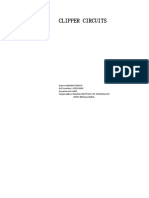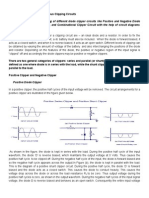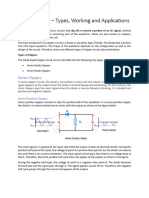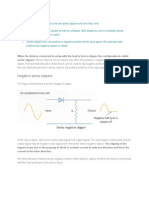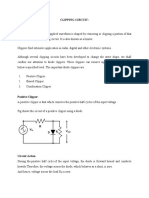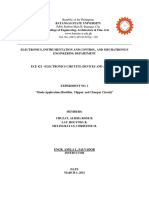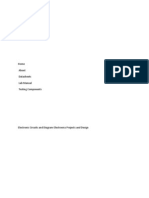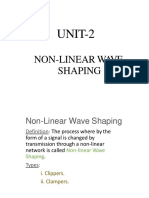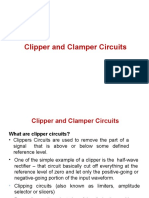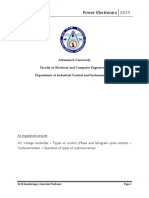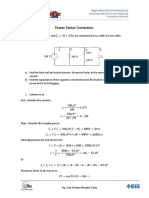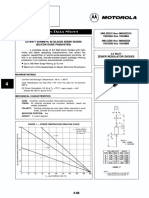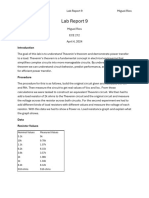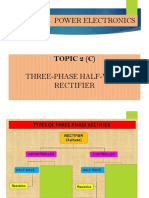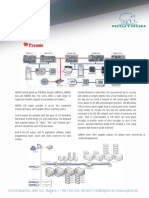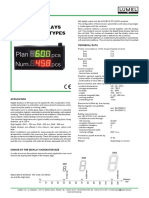Analog Electronics -20EC31P
Week 2 – Wave Shaping Networks
RC Integrator-
The RC integrator is a series connected RC network that produces an output signal
which corresponds to the mathematical process of integration. In RC integrator circuit, the
input is connected to a resistance while the output voltage is taken from across a capacitor.
The capacitor charges up when the input is high and discharges when the input is low. at low
frequencies the reactance, Xc of the capacitor is high while at high frequencies its reactance
is low due to the standard capacitive reactance formula of Xc = 1/(2πƒC). RC integrator also
acts as Low Pass filter.
RC integrator circuit is one in which the output voltage, VOUT is proportional to the integral
of the input voltage
RC Integrator Circuit Example
1 ECE Dept, Shree Vidyadhiraj Polytechnic, Kumta, Uttara Kannada, Karnataka, 581343
�The time constant, τ of the RC integrator circuit is therefore given as:
RC = 100kΩ x 1uF = 100ms.
So if we apply a step voltage pulse to the input with a duration of say, two time constants
(200mS), capacitor will charge to 86.4% of its fully charged value. If this pulse has an
amplitude of 10 volts, then this equates to 8.64 volts before the capacitor discharges again
back through the resistor to the source as the input pulse returns to zero.
RC Integration Circuit
INPUT OUTPUT
Square Wave Triangular Wave
Sine Wave Inverted Cosine Wave
Triangular Wave Sine Wave
RC Differentiator
RC differentiator is a series connected RC network that produces an output signal
which corresponds to the mathematical process of differentiation. RC differentiator circuit,
the input is connected to a capacitor while the output voltage is taken from across a resistance
being the exact opposite to the RC Integrator Circuit. at low frequencies the reactance, Xc of
the capacitor is high while at high frequencies its reactance is low due to the standard
capacitive reactance formula of Xc = 1/(2πƒC). RC Differentiator circuit also acts as High
Pass Filter.
2 ECE Dept, Shree Vidyadhiraj Polytechnic, Kumta, Uttara Kannada, Karnataka, 581343
�VOUT is the derivative of the input voltage, VIN which is weighted by the constant of RC.
Where RC represents the time constant, τ of the series circuit.
RC Differentiator Example
The exact shape of the output waveform depends on the value of the RC time constant.
RC Differentiator Circuit
INPUT OUTPUT
Square Wave Spikes
Sine Wave Cosine Wave
Triangular Wave Square wave
Clippers
Clipper circuits are the circuits that clip off or removes a portion of an input signal,
without causing any distortion to the remaining part of the waveform. These are also known
as clippers, clipping circuits, limiters, slicers etc.
Clippers are basically wave shaping circuits that control the shape of an output waveform. It
consists of linear and non-linear elements but does not contain energy storing elements.
The basic operation of a diode clipping circuits is such that, in forward biased condition, the
diode allows current to pass through it, clamping the voltage. But in reverse biased condition,
no current flows through the diode, and thus voltage remains unaffected across its terminals.
Classification of Clipper circuits
Clippers are basically classified in the following categories:
3 ECE Dept, Shree Vidyadhiraj Polytechnic, Kumta, Uttara Kannada, Karnataka, 581343
�Series positive Clipper circuit
The diode is connected in series with the output thus it is named so.
The positive half of the input waveform reverse biases the diode. Thus it acts as an
open switch and all the applied input voltage drops across the diode. Resultantly providing no
output voltage for positive half of the input waveform. The positive half of the input
waveform reverse biases the diode. Thus it acts as an open switch and all the applied input
voltage drops across the diode. Resultantly providing no output voltage for positive half of
the input waveform.
For the negative half of the input waveform, the diode is in the forward biased state.
Thus it acts as a closed switch causing no any voltage drop at the diode. Hence input voltage
will appear across the resistor, ultimately at the output of the circuit.
4 ECE Dept, Shree Vidyadhiraj Polytechnic, Kumta, Uttara Kannada, Karnataka, 581343
�Series negative clipper circuit
Here, during the positive half cycle of input waveform, the diode becomes forward biased,
thus ensuring a closed circuit. Due to which current appears across the resistor of the circuit.
For negative half of the input waveform, the diode now becomes reverse biased acting as an
open switch. This causes no current to flow through the circuit. Resultantly providing no
output for negative half of the input waveform.
Series positive clipper circuit with bias
Whenever there is a need to clip or remove a certain portion of positive half of input
waveform, series positive clippers with biasing are needed.
1. The case of a Positively biased circuit:
Here in the circuit shown above, we can see that the diode is in forward bias condition
concerning the battery. But positive half of the input waveform puts the diode in reverse
biased condition.
The diode will conduct until the supply voltage is less than the battery potential. As battery
potential dominates the supply voltage, the signal appears at the positive half of output
waveform. But as the supply voltage exceeds the battery potential, the diode is now reverse
biased. Resultantly no further current will flow through the diode.
For the negative half cycle of the input waveform, the diode is forward biased concerning
both supply voltage and battery potential. Hence, we achieve a complete negative half cycle
at the output waveform.
5 ECE Dept, Shree Vidyadhiraj Polytechnic, Kumta, Uttara Kannada, Karnataka, 581343
�2. The case of a Negatively biased circuit:
As we can see in the circuit shown above, the diode is reverse bias due to both supply
voltage and battery potential. This cuts off the complete positive half of the input waveform.
But during the negative half cycle of the input waveform, the diode is in
forward biased condition due to supply voltage but is reverse biased by the battery potential.
Here also initially when battery dominates the supply voltage, the diode is in reverse biased
condition. But, as the supply voltage becomes greater than the battery potential, the diode
will automatically come in forward biased condition. Thus, the signal starts to appear at the
output.
Series negative clipper circuits with bias
Whenever there is a need to clip or remove a certain portion of the negative half of the
input waveform, then series negative clipper circuits with biasing is needed.
The case of a positively biased circuit:
Here in the circuit, we have noticed that for the positive half of input waveform,
the diode becomes forward bias. However, the battery potential causes the diode to be at
the reverse biased condition.
In the beginning, the battery potential is higher than the supply voltage. Thus causing no
current to flow through the circuit at that time. But when the positive half supply voltage
exceeds the battery potential then diode becomes forward biased and starts conduction.
Hence signal appears at the output.
The negative half cycle of the input waveform causes the diode to be reverse biased. At the
same time applied battery potential reverse biases the diode. Thus no any signal is achieved at
the output in such a condition.
6 ECE Dept, Shree Vidyadhiraj Polytechnic, Kumta, Uttara Kannada, Karnataka, 581343
�The case of negatively biased circuits:
For the positive half of the input cycle, supply voltage and battery potential both cause the
diode to be in forward biased condition. Thus complete output for the positive half is
achieved in this case.
But in the case of the negative half cycle of the input waveform, the diode is now in reverse
biased condition. At the same time due to battery potential, the diode is forward biased. So,
until the battery potential is greater than the supply voltage, current flows through the circuit.
Hence output is achieved.
But as the supply voltage becomes greater than the battery potential, the diode will now
become reverse biased and hence conduction stops. Ultimately no any signal appears for that
portion of the input waveform at the output.
Shunt positive Clipper circuits
Now, let’s have a look at the circuit of shunt clippers shown below
Here, the diode is connected in parallel with the load. Hence its working principle is
exactly opposite to that of the shunt clippers. In shunt positive clippers, the output signal is
observed only when the diode is reverse biased.
During the positive half of the input signal, the diode gets forward biased due to which the
current flows through the diode. Hence, due to the parallel combination of diode and load, no
current is observed at the load. Resultantly no output waveform for the positive half is
achieved.
7 ECE Dept, Shree Vidyadhiraj Polytechnic, Kumta, Uttara Kannada, Karnataka, 581343
�On the contrary, during the negative half of the input signal, the diode gets reverse biased.
Thus no current flows through it, and the output current is observed at the load. So, for the
negative half of input, the entire negative half appears at the output.
Shunt negative Clippers circuits
Let’s have a look at the figure shown below of shunt negative clippers.
For negative shunt clippers, during the positive half of input, the diode gets reverse biased.
Thus no current flows through it, and the output current is observed at the load.
Hence output signal is achieved for positive half of the input signal.
During the negative half of the input signal, the diode gets forward biased and hence no load
current is achieved. Ultimately no output is observed for negative half of the input signal.
Shunt positive clipper circuits with bias
Here, we will discuss both the cases of positive and negative biasing separately as we
have done in series clipper with bias.
1. The case of positively biased circuits:
During the positive half of the input cycle, the diode gets forward biased but at the same
time battery potential causes the diode to be at the reverse biased condition.
Until the battery potential is greater than the supply voltage, the reverse biased diode by the
battery potential does not allow the flow of current through it. Hence current flows through
load and signal is observed at the output. But when input voltage increases more than the
battery potential, the diode becomes forward biased due to the supply voltage. Hence,
allowing current to flow through the diode and no output is achieved.
8 ECE Dept, Shree Vidyadhiraj Polytechnic, Kumta, Uttara Kannada, Karnataka, 581343
�In case of negative half of the input cycle, both battery potential and supply voltage reverse
biases the diode. Hence we get a complete negative half cycle at the output.
The case of negatively biased circuits:
In this case, the negative half of the input cycle and the applied battery potential both
causes the diode to be forward biased. Thus current flows through the diode, and no signal is
observed across the output.
During the negative half of the input cycle, the diode is reverse biased due to supply voltage
but is in the forward biased state due to battery potential.
So, here output will not appear at the load until battery potential is higher than the supply
voltage. As the supply voltage exceeds the battery potential, the diode stops conduction due
to the reverse bias condition. Hence signal appears at the output.
Shunt negative clipper circuits with bias
Now, let’s move further and discuss the case of positive and negative biasing separately.
1. The case of positively biased circuits:
In case of positive half of the input signal, the diode gets reverse biased. However, the battery
potential causes the diode to be in forward biased condition. So, until the battery potential is
higher than the supply voltage, the diode conducts due to forward bias. But as the supply
voltage exceeds the battery potential the conduction through diode stops. Ultimately signal
appears at the output.
9 ECE Dept, Shree Vidyadhiraj Polytechnic, Kumta, Uttara Kannada, Karnataka, 581343
�During the negative half of the input cycle, the diode gets forward biased because of battery
potential and supply voltage. Hence, no output signal appears for the negative half of the
input cycle.
2. The case of negatively biased circuits:
During the positive half of the input cycle, the diode gets reverse biased due to both battery
potential and supply voltage. Resultantly, we have complete positive half of input signal at
the output.
During the negative half of the input cycle, the diode gets forward biased due to supply
voltage but is reverse biased by the battery potential. Thus, the output signal is achieved until
the battery potential is higher than the supply voltage.
As the supply voltage exceeds the battery potential, the diode completely starts conduction
and signal does not appear at the output.
Dual clipper circuits
Whenever there is a need to remove a certain portion of both positive and negative
half of the signal, then dual clipper circuits are used.
Let’s have a look at the circuit of dual clipper shown below-
During positive half of the input cycle, diode D1 gets forward biased due to supply
voltage but is in reverse bias state due to battery potential VB1. At the same time, diode D2 is
in reverse bias due to both supply voltage and battery potential VB2.
Until battery voltage exceeds the supply voltage D1 will be in reverse-biased state and D2 is
already in reverse bias condition. Hence signal is achieved at the output. But as the supply
voltage exceeds the battery potential, it causes diode D1 to be forward biased. Hence, no any
further signal for the positive half is achieved in this case.
During the negative half of the input cycle, diode D1 will be reverse biased due to both supply
voltage and battery potential.
10 ECE Dept, Shree Vidyadhiraj Polytechnic, Kumta, Uttara Kannada, Karnataka, 581343
�Conversely, diode D2 will be forward biased by the supply voltage but is reverse biased by
the battery potential VB2.
Until the supply voltage is less than the battery potential, D2 will be in reverse-biased state
and signal appears at the output in this condition. But, as the supply voltage exceeds the
battery potential, D2 will be forward biased. Hence no any signal is obtained at the output.
Clampers
Clamper circuits are the electronic circuits that shift the dc level of the AC signal.
Clampers are also known as DC voltage restorers or level shifter.
These circuits are used to clamp an input signal to a different dc level. It basically
adds dc component to the applied input signal in order to push the signal to either the positive
or negative side. Clamper circuit is a combination of a resistor along with
a diode and capacitor. It sometimes also employs dc battery so as to have an additional
shift in the signal level.
Positive Clamper circuit
As we can see here, the diode is in parallel connection with the load. So we can say reverse
biasing of the diode will provide the output at the load.
Initially, the positive half of the applied input signal reverse biases the diode but the capacitor
is not still charged. So, at this period of time output will not be considered.
For, the negative half of the AC signal, the capacitor now gets fully charged up to the peak of
the AC signal but with inverse polarity. This negative half forward biases the diode that
results in the flow of the forward current through the diode. The next positive half then
reverse biases the diode due to which signal will appear at the output.
At the beginning of the positive half of the AC signal, the diode is in the non-
conducting state that results in discharging of capacitor charge. So, at the output, we will
have the summation of the voltage stored across the capacitor and applied the AC input
signal. This is given by
Vo = Vm + Vm = 2Vm
11 ECE Dept, Shree Vidyadhiraj Polytechnic, Kumta, Uttara Kannada, Karnataka, 581343
�Here as we can in the output waveform shown above, the signal level is shifted upward or
positive side. Hence it is named as positive clamper.
Negative Clamper circuit
At the time when positive half of the AC input is applied, the diode comes to forward
bias condition that results in no-load current at the output. However, a forward current flows
through the diode that charges the capacitor to the peak of the ac signal but again with inverse
polarity. The capacitor here is charged up to the forward biased condition of the diode.
When negative half of the AC signal is applied, the diode now becomes reverse biased. This
allows load current to appear at the output of the circuit. Now, this non-conducting state of
the diode discharges the capacitor. So, at the output, a summation of capacitor voltage along
with the input voltage is achieved.
Hence at the output, we have,
Vo = – Vm – Vm = -2Vm
This results in the downward shift of the signal. Therefore, it is termed as negative clamper
circuit.
Voltage Multipliers
A voltage multiplier is a specialized rectifier circuit producing an output which is
theoretically an integer times the AC peak input, for example, 2, 3, or 4 times the AC peak
input. Thus, it is possible to get 20 VDC from a 10 Vpeak AC source using a doubler,
30 VDC from a Tripler.
voltage doubler
A voltage doubler is an electronic circuit that produces an output voltage that is double the
input voltage. It is a voltage multiplier with a voltage multiplication factor equal to 2. The
circuit is formed by an oscillating AC input voltage, two capacitors, and two diodes. The
input voltage is AC, and the output is DC voltage with twice the peak value of the input AC
voltage.
12 ECE Dept, Shree Vidyadhiraj Polytechnic, Kumta, Uttara Kannada, Karnataka, 581343
�All over the positive half cycle of the AC sine wave, the first diode (D1) is conducting. That
is a forward biased state, and it will charge the connected capacitor (C1) equal to the peak
value of AC secondary voltage of transformer (VSMAX).
This capacitor is unable to get discharged due to the unavailability of a path. So, it will
remain in a fully charged condition.
Next, all over the negative half cycle, the second diode (D2) is conducting or forward biased
state, and the first diode (D1) is non-conducting or in the reversed biased state.
The reversed biased diode (D1) will block the discharging of the connected capacitor (C1),
and the forward-biased diode (D2) will charge the connected capacitor (C2).
Here we can apply Kirchhoff’s voltage law to the outer loop, which starts from the bottom of
the secondary of the transformer (the lower end is negative and the top end is in positive
polarity) in the clockwise direction.
13 ECE Dept, Shree Vidyadhiraj Polytechnic, Kumta, Uttara Kannada, Karnataka, 581343
�That is the voltage across the capacitor; C2 will be equal to two times the peak value of input
transformer secondary voltage (2VSMAX).
Throughout the next positive half cycle of AC input, the second diode (D2) will be open due
to the reversed biased condition. So, the second capacitor (C2) will get discharged through the
load and the output voltage (Vout) < 2VS MAX.
Otherwise, the two capacitors will be in the charged condition as said above. If there is a
load, then in the next cycle, the C2 will get recharged again.
Voltage tripler
Using the method of extension of half-wave voltage doubler circuit, any voltage
multipliers (Tripler, Quadrupler etc) can be created. When both the capacitor leakage and
load are small, we can achieve tremendously high DC voltages by means of these circuits that
include several sections to step-up (increase) the DC voltage.
14 ECE Dept, Shree Vidyadhiraj Polytechnic, Kumta, Uttara Kannada, Karnataka, 581343
� Practice
1. Generate the following waveforms from sinusoidal waveform.
a. Trapezoidal waveform
Simulation Video link- https://youtu.be/q3lBgd0C3To
Required Components:
1. Function Generator
2. Resistor 1K
3. 2 Diodes
4. 2 Voltage Sources
5. Oscilloscope
6. Connecting Wires
Circuit Diagram
10V
1KHz
Waveform
Input Waveform
15 ECE Dept, Shree Vidyadhiraj Polytechnic, Kumta, Uttara Kannada, Karnataka, 581343
� Output Waveform
b) . Generate Positive cycle using Sinusoidal Waveform
Simulation Video link- https://youtu.be/WO_v3u1AHDc
Required Components:
1. Function Generator
2. Resistor 10K
3. 1 Diodes
4. Oscilloscope
5. Connecting Wires
Circuit Diagram
16 ECE Dept, Shree Vidyadhiraj Polytechnic, Kumta, Uttara Kannada, Karnataka, 581343
�Input Waveform
Output Waveform
17 ECE Dept, Shree Vidyadhiraj Polytechnic, Kumta, Uttara Kannada, Karnataka, 581343
� 2. Construct and verify voltage doubler and tripler circuit to multiply the input
voltage.
a) voltage doubler
Simulation Video Link- https://youtu.be/Lhra1KU6l4A
Required Components:
1. Function Generator
2. Capacitors
3. Diodes
4. Multimeter/Oscilloscope
Circuit Diagram and Output
18 ECE Dept, Shree Vidyadhiraj Polytechnic, Kumta, Uttara Kannada, Karnataka, 581343
� b) voltage Trippler
Simulation Video link- https://youtu.be/MmB40dmzKms
Required Components:
5. Function Generator
6. Capacitors
7. Diodes
8. Multimeter/Oscilloscope
Circuit Diagram and Output
19 ECE Dept, Shree Vidyadhiraj Polytechnic, Kumta, Uttara Kannada, Karnataka, 581343


